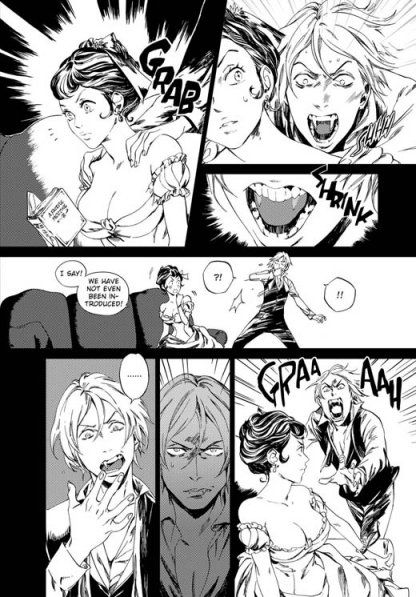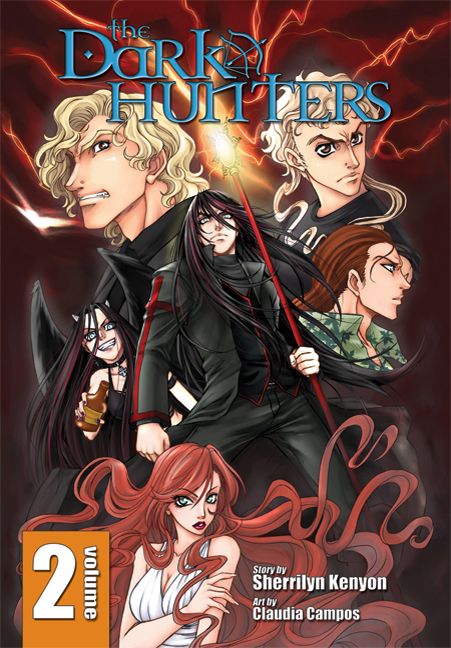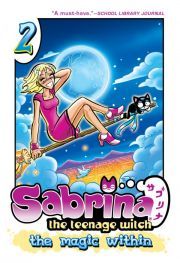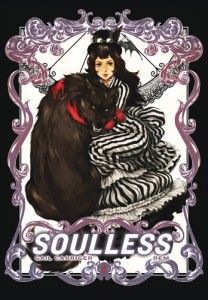This week, it's the hotly-contested category of non-Japanese manga up for discussion. There are many sides to this debate, but the main arguments are that "manga" should be anything produced in Japan versus "manga" being a style. In general, most use a strict definition that manga is produced in Japan by Japanese artists in the Japanese language, which is rather un-ambiguous. "Manga" is used by many companies to market domestically-produced series to teens, and once upon a time, other Asian comics as well. Still, there's nothing wrong with a good manga-influenced style, and with modern forays into domestically-produced manga (OEL, Global Manga, or whatever you'd like to label it), the line between gets blurrier and blurrier. This week, I'm looking at 3 different series, all aimed at teenage girls (as that's what I have handy right now), but for each one, I'll discuss how much it is or isn't like a manga.
Dark-Hunters - Story by Sherrilyn Kenyon, Art by Claudia Campos (4 volumes)
This is a late substitution, as the first series I had planned to feature this week (The Other Side of the Mirror, by Jo Chen) turned out not to be a domestically-produced series published by Tokyopop, but rather a serialized work in a Taiwanese manhua magazine. Sadly, the only other series I have that fits this topic is Dark-Hunters, a fairly middle-of-the-road release from St. Martin's. Based on a series of Urban Fantasy novels, the first story arc deals with Kyrian and Amanda. Kyrian is an ancient Greek general-turned-vampire on the trail of an evil sort of vampire when he is inadvertently hancuffed to Amanda. Amanda is the "normal" sister in a family of witches, and was handcuffed to Kyrian as a result of being mistaken for her sister. The two need to find the correct Greek god to undo the handcuffs so that Kyrian can stop an ancient evil that's tied into a quest for revenge. There's also a romance between Kyrian and Amanda, though it's not as hot and heavy as you might expect for an adaptation of a book titled "Night Pleasures," as the comic is rated 13+. Each volume of the Dark-Hunters novels covers a different couple and provides a different happy ending, and the first two volumes of the manga adaptation covers one of these stories. The story feels a bit too condensed in manga form (there are too many characters with a lot of crazy things going on, as you might have guessed), and the campiness present in the Urban Fantasy genre doesn't translate very well into a comic for 13-year-olds. It's a license series, pure and simple, and while not terrible, it is very utilitarian. But how is it like a manga? The linework is heavier than what you might find in a Japanese manga, particularly in comics meant for girls or women, of which it otherwise looks fairly similar. Facial proportions are also slightly off in terms of looking like a manga, which isn't necessarily a bad thing. There is also less screentone, but otherwise, in terms of panel layout and flow and speed of reading, it's a lot like a manga. The art is, overall, very functional, but without a lot of character. Likely there won't be very many aside from diehard fans of the novels seeking these out, but it does appear that they were successful enough that St. Martin's recently started publishing a spin-off series.
Sabrina the Teenage Witch: The Magic Within - Story and Art by Tania Del Rio (4 volumes)
This one aimed more at tween girls, The Magic Within is a manga-style story arc that ran in issues 58-100 of Sabrina the Teenage Witch. Early chapters lean heavily towards one-off type stories, with themes like Sabrina learning the value of asking the boy she wants to the dance herself, the importance of not breaking the rules, how not to judge people too quickly, et cetera. But an overarching plot begins to come into play more and more towards the end of volume 2, when Sabrina and her witch friend Llandra start to suspect the magic Queen and the source of all magic are in danger and get drawn into a dark and political plot in the magic realm. Of the three featured series here, this one is the least manga-like. The character designs and linework are pure Archie-style, and while the compiled volumes are in black and white, I suspect it originally ran in color (manga uses halftone patterns for grayscale whereas this series uses computer-generated gradients that look like they may have been color at one point, though the high quality doesn't rule out an original run in grayscale). I like the art in this series, as the inherent Archie style mixed with manga touches gives it a lot of character. It has a LOT more dialogue than a manga would, and reads more slowly as a result (chapters of manga are designed to be read very quickly). It also has slightly more obvious moral lessons in each chapter, which is a very Archie touch. Manga-style flourishes include the panel layouts, the ongoing and drama-heavy plot, Japanese(-ish) side characters and folklore references, and iconography one would only see in manga, like veins on a forehead, the characters sometimes growing smaller, et cetera. Only the first two volumes are available right now, and while the first volume skewed slightly too young for my taste, admittedly, the plot was getting more interesting by the end of volume two. I'm not sure that older audiences would appreciate this, but the ongoing plot was more to chew on than the (I assume) more traditional earlier one-shot stories, and this series might be just the thing for manga-loving tweens who might be too young for the steamier romance manga titles. The series ran from 2004-2009, but the manga-sized digest volumes are being released through the end of the year.
Soulless - Story by Gail Carriger, Art by Rem (5 volumes)
Yen Press has a current and very successful line of domestic manga based on young adult novels. This series, oddly, is based instead on a series of Urban Fantasy novels for adults, but one that translates well into comics for older teens. Set in Victorian-era London, Alexia Tarabotti finds herself 20 years old and (gasp!) unmarried, which makes her a spinster. It's a condition she is happy with, as she herself is not fond of the ridiculous courtship and social ringmorale of the age. Another condition she suffers is being a Soulless, or one that can touch a werewolf or vampire and turn them human again for as long as her hands lie on them. At the beginning of volume one, she becomes entangled with Conall Maccon, the Alpha Wolf of the local pack, and the two of them go on hating each other through the entire first volume as they investigate a mystery that involves various steampunk-ish mechanical oddities, disappearing vampires, and Alexia's good name. Each volume of the manga faithfully adapts one of the novels, of which there are five total. It's a fine story, but in the adaptation, some of the best parts of the novel (namely, Alexia's sarcastic inner monologue and the idiosyncratic and witty descriptions of events, items, and settings) are lost. The charming back-and-forth barbs that Conall and Alexia exchange are intact, but without the copious descriptions of the outfits and everything about steampunk Victorian England, the story reads quickly a bit anemically, though still quite entertaining. I mentioned in the Sabrina description that manga read fast, so in that way, Soulless succeeds. Rem does a fine job of translating the setting and outrageous outfits and inventions into art, and in terms of panel layout, screentone use, character designs and (lack of) backgrounds, it looks an awful lot like a manga from Japan. The only thing that looks slightly off are the faces, hairstyles, and some of the linework, but it doesn't look like a different style, as the Sabrina series did. Domestically-produced manga in 2013... looks a lot like Japanese manga, if that's what the company is trying for (though there are still plenty of artists to whom manga is merely an influence). Volume 3 of Soulless is due out next month.





